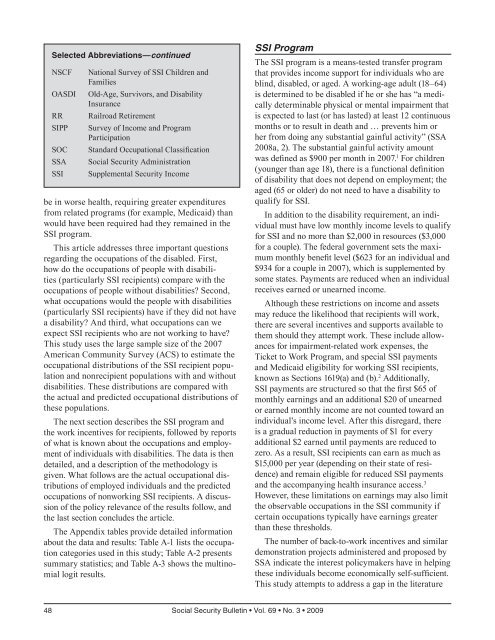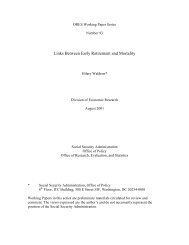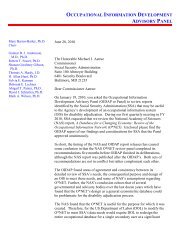Selected Abbreviations—continuedNSCFOASDIRRSIPPSOCSSASSINational Survey of SSI Children andFamiliesOld-Age, Survivors, and DisabilityInsuranceRailroad RetirementSurvey of Income and ProgramParticipationStandard Occupational Classification<strong>Social</strong> <strong>Security</strong> AdministrationSupplemental <strong>Security</strong> Incomebe in worse health, requiring greater expendituresfrom related programs (for example, Medicaid) thanwould have been required had they remained in theSSI program.This article addresses three important questionsregarding the occupations of the disabled. First,how do the occupations of people with disabilities(particularly SSI recipients) compare with theoccupations of people without disabilities? Second,what occupations would the people with disabilities(particularly SSI recipients) have if they did not havea disability? And third, what occupations can weexpect SSI recipients who are not working to have?This study uses the large sample size of the 2007American Community Survey (ACS) to estimate theoccupational distributions of the SSI recipient populationand nonrecipient populations with and withoutdisabilities. These distributions are compared withthe actual and predicted occupational distributions ofthese populations.The next section describes the SSI program andthe work incentives for recipients, followed by reportsof what is known about the occupations and employmentof individuals with disabilities. The data is thendetailed, and a description of the methodology isgiven. What follows are the actual occupational distributionsof employed individuals and the predictedoccupations of nonworking SSI recipients. A discussionof the policy relevance of the results follow, andthe last section concludes the article.The Appendix tables provide detailed informationabout the data and results: Table A-1 lists the occupationcategories used in this study; Table A-2 presentssummary statistics; and Table A-3 shows the multinomiallogit results.SSI ProgramThe SSI program is a means-tested transfer programthat provides income support for individuals who areblind, disabled, or aged. A working-age adult (18–64)is determined to be disabled if he or she has “a medicallydeterminable physical or mental impairment thatis expected to last (or has lasted) at least 12 continuousmonths or to result in death and … prevents him orher from doing any substantial gainful activity” (SSA2008a, 2). The substantial gainful activity amountwas defined as $900 per month in 2007. 1 For children(younger than age 18), there is a functional definitionof disability that does not depend on employment; theaged (65 or older) do not need to have a disability toqualify for SSI.In addition to the disability requirement, an individualmust have low monthly income levels to qualifyfor SSI and no more than $2,000 in resources ($3,000for a couple). The federal government sets the maximummonthly benefit level ($623 for an individual and$934 for a couple in 2007), which is supplemented bysome states. Payments are reduced when an individualreceives earned or unearned income.Although these restrictions on income and assetsmay reduce the likelihood that recipients will work,there are several incentives and supports available tothem should they attempt work. These include allowancesfor impairment-related work expenses, theTicket to Work Program, and special SSI paymentsand Medicaid eligibility for working SSI recipients,known as Sections 1619(a) and (b). 2 Additionally,SSI payments are structured so that the first $65 ofmonthly earnings and an additional $20 of unearnedor earned monthly income are not counted toward anindividual’s income level. After this disregard, thereis a gradual reduction in payments of $1 for everyadditional $2 earned until payments are reduced tozero. As a result, SSI recipients can earn as much as$15,000 per year (depending on their state of residence)and remain eligible for reduced SSI paymentsand the accompanying health insurance access. 3However, these limitations on earnings may also limitthe observable occupations in the SSI community ifcertain occupations typically have earnings greaterthan these thresholds.The number of back-to-work incentives and similardemonstration projects administered and proposed bySSA indicate the interest policymakers have in helpingthese individuals become economically self-sufficient.This study attempts to address a gap in the literature48 <strong>Social</strong> <strong>Security</strong> Bulletin • Vol. 69 • No. 3 • 2009
on the differences between the occupations SSI recipientshave and those of the nonrecipient populationswith and without disabilities. By understanding thedifferences between the occupations of these groups,policymakers may be able to develop work incentivesand vocational rehabilitation programs that will helpthese individuals return to the work force in a mannerthat will enable them to be self-sufficient. Thismay result in placing these individuals in occupationsknown to provide either immediate earnings or withhigher earnings potential.Previous LiteratureAlthough several previous analyses have focused onthe labor force participation of the SSI and <strong>Social</strong><strong>Security</strong> Disability Insurance (DI) beneficiarypopulations (see, for example, Neumark and Powers(2003/2004); Muller, Scott, and Bye (1996); Autor andDuggan (2003); Hennessey and Muller (1995); Hennessey(1997); Muller (1992)), there have only beena handful of studies on the occupations of recipientswho work (see, for example, Schechter (1999)). 4Most related occupational research has focused onall individuals with disabilities, who generally haveless severe disabilities and greater labor force participationthan the SSI population. Haveman and Wolfe(1990) and Wolfe and Haveman (1990) summarize theresearch of the employment patterns of individualswith disabilities through the mid-1980s, which wascharacterized by declining labor force participationrates. The employment of individuals with disabilitiesappears to be more cyclical than the nondisabledpopulation (Yelin and Katz 1994).The general decline in the employment rates ofindividuals with disabilities over the past few decades,shown by Burkhauser, Houtenville, and Wittenburg(2003), may be expected to translate into a tighterdistribution of occupations for SSI recipients and otherworkers with disabilities. The changes in occupationalrequirements in the occupations of those with disabilitiesmay also affect the occupational distribution (Stapleton,Goodman, and Houtenville 2003). However,Trupin and Yelin (2003) found no consistent trend inchanges in the share of occupations held by those withand without disabilities from 1970 through 2001.Occupation is common as an explanatory variablein regressions of earnings or labor force participation(for example, Muller (1992), Hotchkiss (2004), Ozawaand Yeo (2006)), but it is uncommon as the dependentvariable in the literature on disability, especially on theSSI and DI populations. Most studies consider broadoccupational categories, which mask finer occupationdefinitions. For example, Yelin and Cisternas (1996)used the National Health Interview Survey to showthat 17.2 percent of individuals with disabilities wereemployed as professionals, followed closely by servicejobs at 16.1 percent. They found that the change inoccupation mix between 1970 and 1992 affected thosewith and without disabilities in a similar manner.Their grouping of occupations into nine categoriessheds light on the general type of jobs performed, butlacks detail regarding specific occupations.Stoddard and others (1998) report tabulations of theoccupations of workers with disabilities from McNeil(1993), based on the 1991 Survey of Income and ProgramParticipation (SIPP). They show that four occupations(out of 58) account for 25 percent of occupationsof workers with disabilities—executive and administrative,machine operators, food preparation and service,and sales (retail and personal services). Hale, Hayghe,and McNeil (1998) also use the SIPP and find that individualswith severe disabilities are most likely to be inservice occupations or work as operators, fabricators,and laborers. It is likely, however, that employmentin some occupations (for example, laborers) may be acontributing cause of the disability, and the occupationsof those with disabilities severe enough to receive SSIpayments or DI benefits may be different.Some studies have revealed information on thecharacteristics of the occupations of individuals withdisabilities or the DI beneficiary or SSI recipient populations,but not the occupations themselves. Yelin andTrupin (2003), for instance, found that individuals withdisabilities are less likely to be employed in traditionaloccupations or occupations that are economicallyand psychologically rewarding. The skills required incertain occupations and the level of accommodationmay affect what types of jobs individuals with disabilitiescan perform. “Whether persons with disabilitiesare increasingly relegated to peripheral jobs withinthe growing and declining sectors of the economy orwhether, instead they get the kinds of jobs and theworking conditions they want and in which they andtheir workplaces can succeed” (Yelin and Cisternas1996, 55) is likely more important for those with themost severe disabilities and those with low labor forceattachment (who are more likely to be SSI recipients).Workers with disabilities are more likely to havelower levels of education (Hale, Hayghe, and McNeil1998; Steinmetz 2006). This is especially true of SSIrecipients (DeCesaro and Hemmeter 2008) and maylimit the occupational choices available to them.<strong>Social</strong> <strong>Security</strong> Bulletin • Vol. 69 • No. 3 • 2009 49
- Page 1 and 2:
Social SecuritySocial SecurityBulle
- Page 3: Social SecurityBulletin Vol. 69, No
- Page 6 and 7: Perspectives77 An Empirical Study o
- Page 8 and 9: Selected Abbreviations—continuedM
- Page 10: within the next few years (Aglira 2
- Page 14 and 15: coverage varies significantly by ra
- Page 16 and 17: non-Hispanic white, and college edu
- Page 18 and 19: same groups (Table 6). For the last
- Page 20 and 21: from DB to DC pensions is accelerat
- Page 22 and 23: Table 8.Percent of individuals who
- Page 24 and 25: not necessarily the largest gains a
- Page 26 and 27: shoring-up DB plans before those pl
- Page 28 and 29: Table B-1.Percent change in mean pe
- Page 30 and 31: Table B-3.Percent of individuals wh
- Page 32 and 33: ReferencesAaronson, Stephanie, and
- Page 35 and 36: Social Security Administration’s
- Page 37: Chart 1.Historical expansion of Soc
- Page 40 and 41: self-employment information for the
- Page 42 and 43: (Cronin 1985). The final earnings r
- Page 44 and 45: prior to 1950, first year of earnin
- Page 46 and 47: average indexed monthly earnings (A
- Page 48 and 49: 13For an explanation of how the sel
- Page 50 and 51: Kopczuk, Emmanuel Saez, and Jae Son
- Page 53: Occupations of SSI Recipients Who W
- Page 57 and 58: prediction models. Table A-1 lists
- Page 59 and 60: Occupational Distributions of theEm
- Page 61 and 62: similar, only 4 percent of the popu
- Page 63 and 64: Table 5.Estimated occupational dist
- Page 65 and 66: Table 7.Predicted Herfindahl-Hirsch
- Page 67 and 68: Table 9.Estimated occupational dist
- Page 69 and 70: Table 11.Average annual wages of wo
- Page 71 and 72: Table A-2.Means and standard errors
- Page 73 and 74: Table A-3.Coefficients and standard
- Page 75 and 76: Table A-3.Coefficients and standard
- Page 77 and 78: Table A-3.Coefficients and standard
- Page 79 and 80: management, professional, and relat
- Page 81: Stapleton, David C., Nanette Goodma
- Page 84 and 85: Selected Abbreviations—continuedO
- Page 86 and 87: The 1983 Amendments to the Social S
- Page 88 and 89: Chart 1.Proportion of new claimants
- Page 90 and 91: Table 4.The evolution of the ARF an
- Page 92 and 93: for the test of equality of means b
- Page 94 and 95: Table 8.Average monthly Social Secu
- Page 96 and 97: in the chart, especially for men, t
- Page 98 and 99: 6This is a very important character
- Page 100 and 101: Benítez-Silva, Hugo, Berna Demiral
- Page 103 and 104: OASDI and SSI Snapshot andSSI Month
- Page 105 and 106:
Monthly Statistical Snapshot, Augus
- Page 107 and 108:
Table 2.Recipients, by eligibility
- Page 109 and 110:
SSI Federally Administered Payments
- Page 111 and 112:
Table 7.Average monthly payment, by
- Page 113:
Awards of SSI Federally Administere
- Page 116 and 117:
Copyright—Authors are responsible
- Page 119 and 120:
Program Highlights, 2009Old-Age, Su








